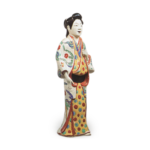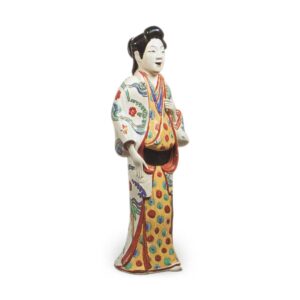
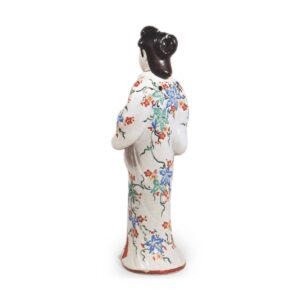
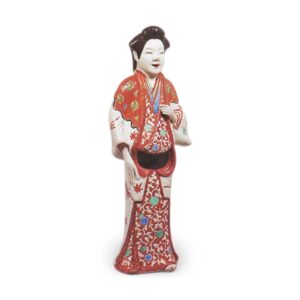
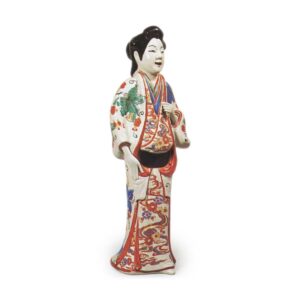
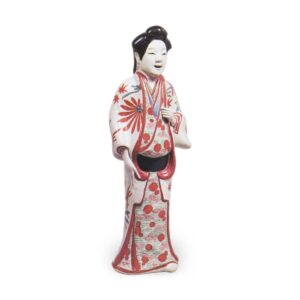

This doll represents the beauty commonly known as Kanbun Bijin, and the figure is exactly the same as the original. Her hair is tied into a gosho topknot, and she wears a kosode and uchikake (a type of kimono worn by women in the Edo period). Gosho-toge was a hairstyle that became popular around the Kanbun period, and was originally worn by women serving the imperial court, who wrapped their hair around a Kougai (hairpin) so that it could be easily lifted and pulled down, but it eventually came to be worn by prostitutes and merchants. All of these works illustrated here are thought to represent prostitutes. The fact that these dolls were made for prostitutes can be inferred from the fact that the “Saiyosho Roku” of Bunka 4 (1910) describes this type of doll and gives her name as “Tokuko Yoshino no Zoinari” (“Tokuko Yoshino no Zoinari”).
The patterns of kosode and uchikake are also similar to those illustrated in the Kanbun hinagata and other works, suggesting that these dolls were made between the Kanbun and Genroku periods. In addition, the Barley House Collection Catalog of England, dated 1688 (Jokyo 5), includes an entry for this type of deer figurine and a female figure, so it is clear from European records that these dolls were made around the same time. Moreover, Figures 26-28 and 161-162 were all imported from England in recent years.
The first doll has a yellow ground with a polka-dot kosode and a large noshi (dried dried sea weeds) and running water design on the back of the uchikake. The second doll wears a kosode with a detailed design of autumn leaves and cherry blossoms, and a uchikake with a vine and grass design. The third doll wears a kosode with a white arabesque pattern on a red ground, and a uchikake with designs of autumn leaves and the character for “tree,” which is also seen in hina dolls of the Kanbun period.
Iroe doll 4 wears a kosode with a Sakuragawa pattern and a grape arabesque pattern, and Iroe doll 5 wears a kosode with a blue ocean wave polka dot pattern on a haze and a kosode with the character for “tree”, autumn leaves and hemp palm leaves. Doll 6 wears a kosode with autumn leaves scattered in a gauze pattern and a uchikake with a lotus arabesque pattern on iron wires. Both dolls are made of very high quality milky white handmade cloth, and the bottom of Shiki-e Doll 5 and Shiki-e Doll 6 still has some fabric lines. The design of each doll is based on the Kanbun Hinagata and other works, while using a method of expression unique to shiki-e porcelain.

